By: debbie lynn elias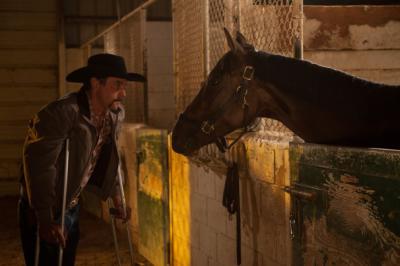
Who among us doesn’t love a longshot; especially if you’ve got the winning bet. One such winning bet paid off on 50 to 1 odds at the 2009 Kentucky Derby, not only for Chip Woolley and Mark Allen, owners of Derby winner Mine That Bird, but pays dividends again now with one of the truest feel good films of the summer, 50 TO 1. Written and directed by Jim Wilson, Oscar winning former producing partner with Kevin Costner, and co-written by Faith Conroy, 50 TO 1 is inspired by the true story of Mine That Bird and his owners, Woolley and Allen. Captivating us with the story of the little two-year old horse that could, and did, Wilson makes us all feel like winners. Thanks to beauteous cinematography by Tim Suhrstedt, 40 scenic locations throughout America, including actual lensing at Churchill Downs, winning Mine That Bird jockey Calvin Borel playing himself and the film debut of a new equine star, Sunday Rest as Mine That Bird, my money is on 50 TO 1 to win a place in your heart.
As the film opens we meet Chip Woolley and Mark Allen, two guys who just happen to be in the wrong bar at the wrong time and get into a knock down drag out Old West style brawl. While Allen would head up to Alaska and all the monetary potential of gold laden oil pipelines, Woolley and his brother end up as rather down on your luck horse trainers. But as luck would have it, years later the two would reconnect in New Mexico with Allen having hit the mother lode and now a successful businessman and racehorse owner and Woolley with hat in hand seeking a job as a trainer for Allen’s stable.
A longshot in life once himself, Allen doesn’t just give Woolley a chance, they two of them, together with Allen’s partner and equine veterinarian Leonard “Doc” Blach, decide to give a little horse with a lot of heart a chance – Mine That Bird. A scrawny little thing, Bird has phenomenal speed but falls apart in the homestretch. Is it his training? The jockey? Against Doc’s good judgment, Allen “has a hunch” that Woolley and Bird can deliver. And Woolley has undying faith in Bird.
Facing obstacles at every turn, especially their boozing, brawling, womanizing selves, it takes a near death experience for Woolley to see the light of day and realize that his faith in Bird will be rewarded when he starts working with Bird and not expecting the horse to win races alone. Joining in the fray is Allen’s female training jockey, Alex, a helluva rider who serves as a constant instigator and antagonist for Woolley. So imagine the everyone’s surprise when Allen gets a call informing him that thanks to his Canadian winnings, Bird qualifies to run in the Kentucky Derby.
Now, anyone that knows anything about the Derby knows it’s all about the bluebloods, high society, royalty and money when it comes to horse racing at the Derby, certainly not a motley crew of rowdy New Mexico cowboys with a smaller than average two year old horse that can’t pull out a win.
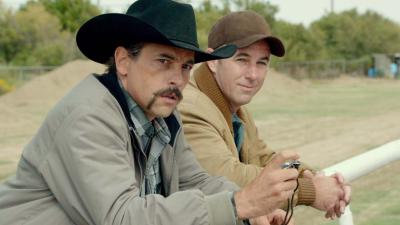
As Chip Woolley, Skeet Ulrich gives a determined performance, working the emotional and character arc that takes Chip from obnoxious buffoon to a dedicated trainer and man who wants to do better. Ulrich gets under your skin and makes you not only root for him but want to do so. He makes you believe. So intent on capturing the realism of this story, Ulrich subjected to himself to some extreme physical stunts and pratfalls which mirrored the real life events of Chip Woolley himself (including breaking a motel bed in half and landing on his ass). Notable is that Ulrich plays Woolley in leg cast and on crutches for much of the film as Woolley suffered extensive injuries in a motorcycle accident prior to the Derby. So severe were the injuries that Derby watchers may recall Woolley hobbling into the winner’s circle on crutches in black hat and jacket with tears in his eyes and a catch in his throat. Ulrich is so immersed in the role that at that moment it’s easy to forget this is a film and not a playback of the Derby. A testament to Ulrich’s performance and Wilson’s direction.
I will watch Christian Kane from here to kingdom come. In 50 TO 1, he is clearly comfortable in the role of Mark Allen and slips into it like a well worn horseshoe, but while Kane looks good and is more than easy on the eyes, his acting leaves something to be desired as the performance – and the character – is strictly one-note.
Perfectly cast is William Devane, adding some crotchety elder wisdom and a touch of country bumpkin cow-out-of-pasture humor as Doc while giving the film some grounding. I would be remiss not to mention the casting of extras and minor racing people who are physically spot on with their real life counterparts, and none better than Bruce Eckelman who captures legendary Bob Baffert to a tee.
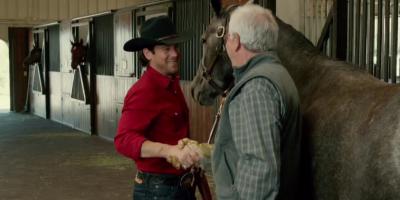
But I have to say, the real winners here (and it’s tough to call win, place or show with this trio) are Madelyn Deutch, Calvin Borel and Sunday Rest. With a rich pedigree as daughter of Lea Thompson and director Howard Deutch and sister to Zoey, Madelyn Deutch deftly gives Alex a feisty spirit that while matching the testosterone fueled “cowboy” that Ulrich and Kane bring to Woolley and Allen, not to mention the spirit within Mine that Bird, she shines and tempers the bar brawl attitude with some class. Works well in a liaising sort of way between cowboys and class at the Derby Ball. Adding to Deutch’s performance are her own skills as a horsewoman which means it’s Deutch you see on the track, it’s Deutch you see on Sunday Rest.
And then there’s the legendary Calvin Borel. Borel is joy personified. And his casting as himself almost didn’t happen. According to writer/director/producer Wilson, his initial thought was “I don’t even know if getting Calvin’s a good idea. . .I’ve got enough scenes and dialogue and interacts that I don’t know how Calvin can necessarily pull this off. Its hard for anybody to play themselves.” By the time Wilson went to Borel, he too, was reluctant. As Wilson relates, Borel had plenty of reasons to say no. “He said, ‘I’m still racing. I can’t take these weeks off to shoot. I’m in my career. I’ve just gotten to the Hall of Fame. I’m looking for my Derby horse. I can’t really do it.’ It was nip and tuck for quite a while. Finally he said, ‘You know what? Let’s give it a shot.’” One of the smartest casting moves Wilson could have made.
As Wilson talks about Calvin Borel, his respect and admiration is beyond evident. “He’s very funny. Having Calvin was such a joy. He was a little nervous the beginning of the first day because it’s cameras and action and he’s working with Skeet [Ulrich] and Christian Kane and Bill Devane and people he knows. He was ‘Oh God. You could tell I’m kinda gulping a little bit that I’m not gonna get through this.’ By noon after the first day, he was so comfortable. He said, ‘You’re in my house now.’ He realized he can play himself and was good at it. And to bring all that emotion to the film, too. He just let it out. The last third of this picture stars Calvin Borel.”

Calling on sense memory and steeped in authenticity and Wilson’s recreation of that specific Derby day, Borel left nothing on the track with his performance. “When he’s doing those scenes, I’m not having to direct him. I’d call “action”, he’d hop on that horse and you’d throw the roses over him and he starts crying and hugging and screaming. It was like ‘Wow!’ . . .He let it all out.” Described by Borel as “freakish”, after filming him on Sunday Rest going full out on the track, he told Wilson, “I felt like I’m in a race. I felt like for that 20 seconds it was just like I was on Bird getting ready for my move and seeing if I had any left.” A treat for Wilson, “[Calvin] wore the same boots he wore at the Derby. He brought in the same silks. He sat at the stool he sits at in the jock’s room. He went to his very locker. That was the photo of his mom and his dad. That’s all his stuff. It wasn’t Hollywood make believe. That was all Calvin.” This is the stuff of which dreams – and emotional underdog sports films – are made.
The real star, however, is Sunday Rest who steals the film, and our hearts, as Mine That Bird. Perhaps one of the most difficult castings because of Mine That Bird’s small narrow stature, and wanting whatever horse was cast to look as much like Bird as possible, Wilson undertook almost Herculean efforts in his horse casting. “ We looked at nearly 400 head of horses. Each time my trainers were out there looking they’d send photos over the internet. I’d make them shoot all four sides and everything they could possibly do – height size, color, the whole thing. Finally we found a match, and a matching character to a good bit, because Bird really was a character. I didn’t want just a look alike” Eventually finding a three-year old thoroughbred in Calgary, Canada named Sunday Rest, what Wilson didn’t realize was the depth of the talent that he bought. “He plays all of the big scenes. There aren’t two horses. Normally in these movies there are 7, 8 or 9 horses that you switch in and out to do various things. But Sunday Rest did the whole movie. He starred in the whole darn thing.” It was thanks to Borel that the search to cast Bird was so arduous. “Calvin always told me, ‘If this horse was another 100 lbs which easily could have been 200 lbs bigger horse, I never would have gone through that hole. I never could have gone through there. Because this horse was so agile and so narrow, I said, ‘Let’s go Bird! I can make that hole.’ Most jockeys wouldn’t have done what Calvin did anyway but the fact that he’s scraping his boot on a little skinny horse is what allowed him to do that. You just don’t do it with the bigger horses.”
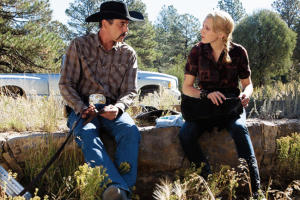
Given that 50 TO 1 is inspired by the true story of Woolley, Allen and Mine That Bird, the outcome is assured, leaving Jim Wilson to tell the backstory and engage us for the 75+ minutes leading up to the Derby race itself. Essentially two stories rolled into one, that of Mine That Bird and getting to the Derby and then not so much the story of Woolley and Allen’s partnership but more Woolley’s journey of self-redemption, that for Wilson is why you make a film and why he wanted to make 50 TO 1. “I was at home watching television with the Derby that year and I saw a race I had never seen before. . . [Bird] destroyed that field. He toyed with them. And it’s 50 to 1 – this wasn’t the favorite that was supposed to do this. He wasn’t on anyone’s radar. That’s what makes it great. I don’t have to make believe with this story. [Woolley and Allen] did meet in a bar fight, all the major movements in this film are spot on. This wasn’t Hollywood saying they nearly lost a horse on the travel or Chip shattered his leg in a motorcycle accident. He did. Everyone of those movements is real.” And it’s the blend of characters that had an appeal for Wilson, and it’s that blend and the different traits that make for some wonderful undertones within the film. Reflecting on Derby day 2009, Wilson recalls, “These guys are so denied any press. You’re there, you’re at the Derby and they didn’t get an interview. These guys didn’t get into a party. It really was a nose up to you. They’re an after thought at best.” And then there’s Chip Woolley. “A guy who had never been to Kentucky, had never been to the Derby, wears all black, he is a cowboy, he wears his heart on his sleeve. You know what he’s all about. He’s not capable of a lie or a fib. It’s not in his make-up. He’s not wired that way. Those characters interested me. When you wander into the Derby and you’re playing with big international monies and historically monies from generations passed down to raise horses and you come from the west, you are an outcast. . . I liked that and I liked that journey. That to me was interesting.”
But that’s not to say there aren’t some problems with the script and this meld of two stories as each, but for the climactic Derby race, feels like it’s gotten the short shrift so that moments in the first and second act feel disjointed. And while establishing the key moment of the initial meeting between Allen and Woolley in a bar brawl is necessary, the scene is too long, wasting time that could have been devoted to creating a better meld or adding some clarity in the second act. While some may call it nitpicking, there are two off-handed dialogue references to the “huge heart” that Mine That Bird has, clearly a knock-off to the well seeded theme within Disney’s “Secretariat” where “huge heart” is a huge part of the Secretariat story. But with 50 TO 1, we never get any real foundation for any dialogue about a “huge heart” pushing Bird to the finish line. The two lines stick out like sore thumbs. Similarly, there’s much reference to Woolley not being a good trainer, but we have no real training sequences so the idea dangles like a bad participle. The lack of sufficient training sequences also leads to a lack of interaction between Bird and Woolley, although there is more of a connection and dynamic and Woolley and Alex. For a film called 50 TO 1, we need to see more of what made Bird a 50 TO 1 shot, not just that he’s owned by “cowboys”.
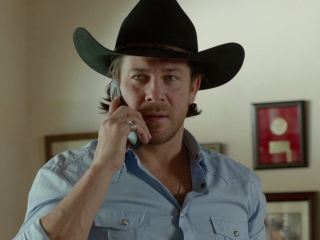
Exquisite is the only word to describe Tim Suhrstedt’s cinematography. Scouting locations together, Suhrstedt was able to “get inside” Wilson’s vision in terms of what he wanted and didn’t want with the film. Being a race horse owner himself, Wilson already knew the horse world, but it’s the vistas of America that give 50 TO 1 a wonderful palette and tonal bandwidth. Proud of the fact that there’s no CGI in play, Wilson “ wanted big spaces so when you first hit New Mexico and you see that little track that Skeet Ulrich is working . . . I said to Tim, ‘Let’s capture this – go as wide as we can. I like big wide vistas but I also want detail on the show so you’ve got to do closeups of the horse.’ I didn’t want it to be in the middle. I wanted to shoot some very wide big beautiful broad vistas. We talked a great deal about going from the west to the east and the colors of the west and the desert and the dirt and the grit and to feel that and as you made your way and transitioned across the country to more greens and flowers, a real change. He embraced every bit of it and then some.” And then there’s a wonderful inter-cutting with actual racing footage – particularly the Derby. The transition between art and reality is seamless. Dazzling are come overhead “Busby Berekley” type shots that create some wonderful heart tugging moments.
Completing the emotional palette is a nuanced score by William Ross that is equally emotive be it capturing the sweeping grandeur of the American southwest, the intimate moments between a trainer and his horse or the heart-stopping thrill of victory.
50 TO 1 – and its new star Sunday Rest – wins your heart by a mile.
Directed by Jim Wilson
Written by Jim Wilson and Faith Conroy
Cast: Skeet Ulrich, Christian Kane, William Devane, Madelyn Deutch, Calvin Borel, Sunday Rest











